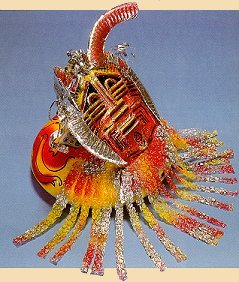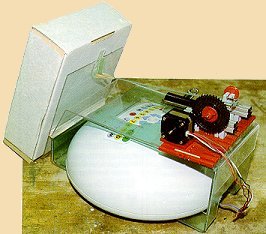
|
Feedback Form

ROAMER A "VEHICLE" FOR DESIGN EDUCATION IN SCHOOLS:

"Despite the relatively short time the Valiant Roamer has been available as a classroom tool, it has already begun to make an important contribution to the education of the nation's children. With Valiant's Design Pack, Roamer is set fair to make an even greater contribution in the 1990's.." Ron Jones, School Inspector for IT with Lincolnshire Local Education Authority. In this article Ron looks at the design capability of the Roamer.
 "Design Activity will arise naturally in a creative classroom": the Witch Doctor design was inspired by a project on African culture. The robot was programmed to perform traditional African dances. |
As Dave Catlin, Roamer's creator, explains in the introductory section to the Roamer Design Handbook, Roamer was developed to provide a creative medium for children to explore design. Its shape was chosen to allow for the creation of a host of characters. Through characterisation, children can be exposed to the whole design process as an enjoyable and rewarding activity. The Design Pack will help to make that dream become a reality.
The Design Pack contains useful materials to enable young designers from KS1 to KS3 of the UK National Curriculum to become actively involved in the whole design process. It contains: The Design Handbook, one Roamer Jacket, a Hat Pattern, eight suction pads, eight widgets, four mounting brackets, four tube brackets, several sheets of PVC (Face Shape Materials) and a packet of M3 screws. It has been deliberately designed as a starter-pack so that the materials can be supplemented from a variety of sources to meet the creative needs of young designers.
Dave uses the Handbook to encourage children to move towards the more advanced use of this remarkable programmable object (it would devalue Roamer to use the word "toy"). Through the book he is able to share his enthusiasm and his professional design experience with children and their teachers. The pages of the Design Handbook are used to gently lead teachers through the whole Design Process. Dave deliberately uses the terminology of the professional designer so that young designers working in the classroom can share the problems, frustrations and delights of the professional, using the same language. He has also taken great care to stress the similarities between the world of the professional and the problems being overcome by those working within the constraints imposed by the curriculum. Dave says, "Design in the classroom is often treated as a simulation of 'Real World' design. However, Roamer characterisation is real design work. It is motivated by educational rather than by commercial needs and takes place in a classroom rather than in an industrial environment." He reminds teachers that design activity will arise naturally in a creative classroom and that Roamer is a powerful addition to this environment.
Teachers will find the Design Handbook a rich source of ideas. It is divided into three sections. There is a brief but important introductory section, followed by a section in which the whole design process is clearly charted with explanations of how its principles and techniques apply to using the Roamer as a design medium. There are many classroom examples and instances from the commercial world throughout this section. The third part gives suggestions for projects.
The following quotations from the Handbook illustrate the tenor of the book:
"Design is a science and an art. It is instinctive - it is creativity flourishing within the discipline of science."
"As a design medium, and through practical experience, Roamer offers children an insight into the excitement, imagination and discipline of a designer."
"The fantasy element in characterisation helps to nurture a free-thinking approach to design, and by using the Design Process the student develops the practical disciplines of the professional designer."
"Design has developed differently in various cultures. Looking at other cultures can provide dynamic ideas."
"Most designs are created by teams combining ideas, expertise and experience. The advantage of group work is already familiar to teachers. Roamer design work is an excellent opportunity for using this method."
"Designs are created from information. The designer will already know the information or can obtain it from various sources. Investigative ability is an essential skill of the designer."
"Designers 'think' through their pencils. Sketching helps designers to clarify and communicate their ideas. Children should be encouraged to sketch their Roamer design."
Several pages in the Handbook illustrate practical skills. These pages perhaps warrant separate publication in the form of activity/skills cards; no doubt resourceful teachers will create such classroom support materials for themselves. The section on how to cut shapes to fit the Roamer's smooth, ellipsoid surface would prove especially useful in this form. This particular section provides accurate information on the Roamer's major and minor axes - useful for setting up a CAD system or for creating a series of Roamer templates.
Another useful section is on fastenings. Anyone who has experienced the frustrations created through children being unable to realise their design because they cannot fasten sections together, will appreciate the principle adopted by Valiant that most fastening techniques used with Roamer need to be quick, simple and temporary. The Handbook details several methods including suction pads, adhesives and widgets: some methods are of a more permanent nature.
One of the great attractions of using Roamer in the classroom is that it serves as a remote computer; it frees the main classroom computer for more general curriculum support. However the Handbook does describe how the Valiant Computer Interface can be used to support design work. The user can DISPLAY programs on the computer and PRINT provides hard copies of programs for project records. Rather than lose programs when Roamer is switched off SAVE enables young designers to develop more complex programs over several sessions, store them on disk and download them back to Roamer at the start of the next session.
 Roamer design projects are not limited to young pupils. This robotic fork lift was developed by thirteen year old pupils of King Edward VI school in Southampton. |
Roamer contains interesting control features and through incorporating some or all of these Control Technology, which is so often a weak area in the curriculum of many schools, becomes a natural extension of design work. Roamer can call upon four outputs capable of operating motors, LEDs, lamps, indeed anything requiring a DC current. It also has a stepper motor drive and one input line capable of being operated by touch sensors, sound sensors etc. The Roamer provides a sensor power supply for light sensors, etc. The Handbook presents a way in which Control can be approached through solving design problems but it does not attempt to explain the science nor the technology of Control. It aims to be practical in its approach, and in this it succeeds. What is important is that design, which is so often "visual only", can now have movement. It can be animated; it can become 'robotised' in the tradition of Isaac Asimov. Here the Computer Interface again proves useful: children can create a library of robot 'behaviour' programs, saved on disk. More complex behaviour programs can be fused together using the Interface's MERGE feature. The Handbook describes the Valiant Roamer Sensor Pack and the Valiant Motor Pack, with ideas of how to use them effectively with children in the classroom environment. The use of these packs does extend the design potential of the Roamer as a design medium and helps to fill a serious gap in the school curriculum.
Towards the end pages of the Handbook, another of Dave Catlin's theories emerges. In addressing the thorny problem of manufacturing, he states that,
"In many commercial design situations the designer may have little to do with the manufacturing process. However, practical experience of manufacturing process is an essential skill. Even though the technologies children use for Roamer designs are vastly different from commercial technologies, children can develop confidence and a practical intuition in making their own robot creations. But above all, a tremendous satisfaction can be attained from making designs they have conceived."
The Handbook goes on to stress the importance of involving all young designers in the evaluative process, in other words, in carrying out a thorough check as to whether the finished product meets the requirements first established at the beginning of the process in the Design Brief. "It is through reflection that the most is learned from each design experience."
There is no doubt that Valiant's Design Pack, especially the Design Handbook, will prove a boon to hard-pressed teachers who realise the educational benefits of developing within their pupils Design and Technology capability. The Handbook is a mine of information and ideas based upon a wealth of practical experience over many years of professional design. It is refreshing to find scattered throughout the book references to the design problems faced by the Valiant design team when Roamer was being created.
The pack fills a design void and pupils fortunate enough to be exposed to Roamer as a creative design tool will experience the excitement, frustrations and triumphs gained through being active participants in the Design Process. Perhaps the product label "Designed and Made in Britain" will become reality again.
| Back |
|---|